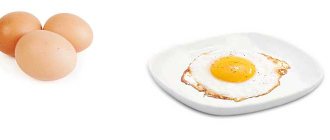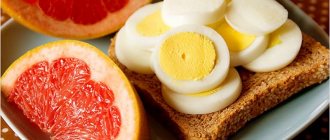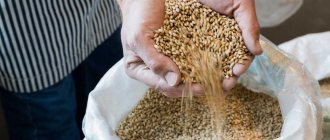How many proteins are in 1 egg (white + yolk)
A significant part of the composition of the egg is made up of proteins - about 13 g per 100 g of product. In 1 piece first category, weighing 50 g - about 6.5 g. The amount of this nutrient in the protein and yolk is different. The yolk contains fewer amino acids, it has more calories, and the protein content does not exceed 16%. The main protein components in the yolk are phosphovitin, livetin, and vitellin.
When cooked, the product does not lose its beneficial properties. Protein content in a boiled egg: 1 pc. – 6 g, in 100 g – 12 g.
The protein contains a protein called ovalbumin (~ 68% of the protein composition), which has antibacterial and restorative properties, the rest is avidin, conalbumin, ovomucin and ovoglobulin. Thanks to a large number of useful amino acids, the product is perfectly absorbed by the body. The protein content of egg whites is 13%, the largest part being water – about 80%.
Chemical composition of egg yolk
On average, the yolk accounts for 33% of the total egg volume. It contains 100% fat-soluble vitamins, carotenoids and 90% microelements.
Chemical composition:
| Name | norm, mg per day | chicken, mg | quail, mg | goose, mg | ostrich, mg |
| water | 2273 g | 74.1 g | 73 g | 70.83 g | 51.6 g |
| ash | — | 1 g | 1.2 g | 1.14 g | 0.9 g |
| beta carotene | 5 | 0,06 | 0,08 | 0,013 | 36,6 |
| vitamin A | 900 mcg | 250 mcg | 483 mcg | 187 mcg | 195 mcg |
| vitamin E | 15 | 2 | 0,9 | 1,34 | 1,05 |
| phosphorus | 800 | 192 | 218 | 208 | 198 |
| sodium | 1300 | 140 | 115 | 138 | 142 |
| calcium | 1000 | 55 | 54 | 60 | 56 |
| choline | 500 | 251 | 507 | 263,4 | 293,8 |
We recommend that you familiarize yourself with the BJU of raspberries
Eggs are an excellent preventative against premature aging. Vitamin D and all B vitamins help reduce the manifestations of aging of the body. It also contains iodine, sulfur, potassium, essential amino acids, and polyunsaturated amino acids.
Fats in 1 egg, raw and boiled
Most of the calorie content of the product (160 kcal) comes from the yolks - more than 70%. The total fat content of a raw egg is 11%; when boiled, this figure remains virtually unchanged. One piece weighing 50 g contains 5.5 g of fat.
Yolks contain 30 g of fat (per 100 g), while whites have zero fat.
The yolk contains many unsaturated fatty acids. Some of them are linoleic, oleic, and stearic, representing, respectively, the groups of polyunsaturated, monounsaturated and saturated acids. Due to the cholesterol it contains, daily consumption of the product should be limited to 3 pieces.
Composition and nutritional value
Eggs are considered a product with high nutritional value. They are included in the diet for weight loss and muscle gain, have many beneficial properties and at the same time are not high in calories, especially if you separate the yolk from the white. The calorie content of an average egg is 79 kcal.
The egg itself consists of two parts - the white and the yolk. Each of them has a different chemical composition, calorie content and contains its own set of elements necessary for our body.
The so-called protein got its name due to the fact that it consists almost entirely of water and high-quality proteins with a complete set of amino acids. The remaining few percent are represented by vitamins, enzymes, lipids and carbohydrates. Protein makes up about 60% of the total weight of the egg and contains 46-50 kcal. It is well absorbed by the body and has a positive effect on its functioning.
More than half of all proteins in egg whites are ovalbumin or egg albumin, a reserve element necessary for the normal development of the embryo. No less important components are the proteins conalbumin and lysozyme, which have an antibacterial effect.
In addition to proteins, egg whites include enzymes, carbohydrates, most B vitamins, microelements and macroelements.
The calorie content of the yolk is much higher than the calorie content of the protein. Like protein, it contains proteins, vitamins and other necessary elements, but most of them are lipids - almost 5 g of mass are needed for them. Fatty acids such as linolenic, palmitic, stearic and others are of great nutritional value.
Hard-boiled and soft-boiled eggs are almost the same in calorie content as raw eggs, but, unlike them, they are much better absorbed. The energy value of fried fried eggs is slightly higher - about 100 kcal, and when frying in vegetable oil it increases to 120-130 kcal. The calorie content of an omelet from one egg is approximately 150 kcal. But the most high-calorie egg product is considered to be egg powder, or dry melange: its energy value per 100 grams is as much as 500-550 kcal.
Calorie table for eggs according to different cooking methods
| Products (100g) | squirrels | fats | carbohydrates | calories |
| A raw egg | 12,8 | 11,5 | 0,7 | 157 |
| Soft-boiled egg | 12,9 | 11,5 | 0,8 | 159 |
| Hard boiled egg | 13 | 11,6 | 0,8 | 160 |
| Egg powder | 45 | 47 | 4,5 | 542 |
| Omelette | 9,5 | 15,4 | 1,9 | 184 |
| Fried egg | 12,8 | 20,8 | 0,9 | 243 |
| Raw protein | 82,5 | 1,7 | 7,1 | 44 |
| Raw yolk | 51 | 52,3 | 4,7 | 352 |
Chemical composition of eggs in the table
| Element | Qty |
| Calcium | 54 mg |
| Magnesium | 13 mg |
| Potassium | 139 mg |
| Phosphorus | 190 mg |
| Sodium | 134 mg |
| Sulfur | 175 mg |
| Chlorine | 136 mg |
| Copper | 82 mcg |
| Manganese | 0.03 mcg |
| Zinc | 1.1 mg |
| Iron | 2.5 mg |
| Iodine | 21 mcg |
| Chromium | 4 mcg |
| Fluorine | 54 mcg |
| Selenium | 31.6 mcg |
Calorie content of quail egg
The calorie content of a quail egg is slightly higher than that of a chicken egg. Its approximate figure is 168 kcal. Of course, based on 100 g of product, because a quail egg itself is much smaller than a chicken egg. Its weight is 10 g, and the energy value is 16-17 kcal, respectively.
Ostrich
The mass of an ostrich egg exceeds the mass of a chicken egg 20-30 times, but the calorie content, on the contrary, is lower - 118 kcal. An average egg weighs 1200 g, and its energy value is estimated at 1400 kcal.
Gusinogo
A goose egg is three to four times larger than a chicken egg, and its calorie content is 300-400 kcal. The energy value of a goose egg per 100 g of product is 185 kcal
Turkey
Turkey eggs are closest to chicken eggs in their weight and properties. The weight of an average egg is 70-80 g. The energy value, based on calculations per 100 g, is estimated at 171 kcal, and the calorie content of one egg is 130 kcal. Turkey eggs contain less protein than chicken eggs, but, on the contrary, more lipids, so they are not considered dietary.
Carbohydrates in eggs
Fans of a healthy lifestyle and those losing weight should not worry about eating chicken eggs, because their carbohydrate content is less than 1 g. More precisely, 0.7 g. A product of the highest and first category, whose weight reaches 80 g, includes about 0.5 g.
A low category and small sized egg will contain between 0.2g and 0.4g of carbohydrates.
The indicator for the yolk (per 100 g of weight) is 1 g, for the white - 0.65 g. Carbohydrates in the product are represented only by sugars. When cooked, the indicator remains virtually unchanged - 0.8 g per 100 g.
Bzhu and kbju yolk of 1 egg
The yolk is a real leader in vitamin A content, its content is 260 mcg. The vitamin has a positive effect on the functioning of the male reproductive system. They contain a lot of choline, which helps brain function, stimulates the nervous system, helps cope with excess weight, and normalizes fat metabolism. It is useful for women as it contains a lot of iron, which is important for regular blood loss. And all this with low energy values.
Chicken
A chicken egg weighs on average from 35 to 77 g. Kbju yolk per 100 g:
- 4.0 g proteins;
- 12.0 g fat;
- 1 g carbohydrates.
Nutritional value – 225.0 kcal or 941 kJ. With an average yolk weight of 20 g, it is easy to calculate that with moderate consumption, no harm will be done to the figure.
We recommend that you familiarize yourself with BZHU bulgur
When fried or boiled, the calorie content increases and is equal to 358 kcal per 100 g.
Quail
This product is considered dietary and suitable for baby food. But we must remember that the cholesterol content in quail is higher, but there are fewer calories. They are 4-5 times smaller in size than chicken ones. The yolk is also high in vitamin A and choline.
Bju yolk per 100 g:
- 13.1 g protein;
- 12.0 g fat;
- 0 g carbohydrates.
Nutritional value is 168 kcal or 703 kJ. There are 844.0 g of cholesterol per 100 g, so people with heart disease should avoid consuming this product. In terms of the risk of contracting salmonellosis, quail is the safest, although you can never be 100% sure.
Gusinogo
This product is approximately 4 times larger than chicken products, and the average weight is 200 g. It is difficult to find them in stores, since geese do not lay eggs as often as chickens. It is not customary to consume them raw, since these poultry are not known for their cleanliness, so there is a high risk of contracting salmonellosis. Boiled and fried, they can be safely consumed, just increase the heat treatment time.
We recommend that you familiarize yourself with the BZHU of grapes
Bzhu 100 g of yolk equals:
- 13.9 g protein;
- 13.3 g fat;
- 1.4 g carbohydrates.
Calorie content – 185 kcal, ratio 1:1:0.1 or 31%/66%/3%.
Ostrich
Ostriches lay eggs only in the warm months of the year, and their size can reach 2.2 kg, the minimum value is 1.2 kg, which is equal to 25-36 chicken eggs. The yolk of ostriches is small - about 350 g. Compared with chicken, ostriches have minimal calorie content and a relatively low amount of cholesterol, that is, they are the optimal product for maintaining a figure.
But it will take more than an hour to boil 1 egg. The product can be stored for up to 3 months, but if the shell is at least partially opened, it must be used within 3 days.
Bju yolk per 100 g:
- 12.2 g protein;
- 11.7 g fat;
- 0.70 g carbohydrates.
Calorie content -118 kcal or 493 kJ.
Harm and contraindications
Just like any other product, eggs have a number of contraindications.
- Individual intolerance . Of course, people with egg allergies will have to avoid them. Adults and especially children with hypersensitivity should also be careful - ovomucoid, contained in egg white, often causes an allergic reaction. However, in children by the age of five or six, allergies often go away on their own.
- Cholesterol . Egg yolks contain cholesterol, and this should be taken into account primarily by people prone to cardiovascular diseases. To avoid health risks, it is recommended to eat no more than two eggs per day or separate the yolk from the white. The latter is safe even in large quantities.
If you eat eggs frequently, it is recommended to include fruits, vegetables, and berries in your diet. These natural antioxidants can normalize blood cholesterol levels.
- Salmonella. It should be taken into account that salmonella bacteria may be found in eggs, especially domestic eggs. It can cause serious gastrointestinal diseases, so you need to follow a few simple rules - wash eggs with soap and cook before cooking and cook for longer than ten minutes.
Orgasm “Virtual Reality”
Soft and relaxing, this type of orgasm is easily achieved without the help of a partner. After some training, of course.
How to achieve?
In order to master this technique, you need to properly train the vaginal muscles. To begin, squeeze them as if you were trying to hold something with their help. Stay in this position for 2-3 seconds, then relax your muscles. Repeat this exercise for a minute or a minute and a half. Then move on to shorter contractions and don't stop for another minute. Focus on these movements, feel how blood rushes to the vaginal area. Continue rhythmically squeezing and unclenching your vaginal muscles for a couple more minutes, you can accompany this action with erotic fantasies - and feel the approach of orgasm. The main thing is not to stop moving. Exercise by squeezing and unclenching your vaginal muscles 20 times in a row, three times a day. Then, after a week or two, their tone will be quite sufficient so that you can experience an orgasm at any time of your own free will. This technique can be used not only alone, a similar effect can be obtained by actively working the vaginal muscles during intercourse. Moreover, the partner will be guaranteed additional pleasure. Fireworks Orgasm
Consecutive bursts of pleasure, fast and rhythmic, ending in a delicious explosion. Using this technique, you can experience a whole series of vivid orgasms, following one after another. In total, you can last almost an hour at the peak of pleasure.
How to achieve?
Here a lot depends on the patience and skill of the partner.
He must bring you almost to the orgasm over and over again, slowing down literally a few seconds before the finale. The best way to do this is to stimulate the clitoris with your fingers or tongue. In order to slow down, it is enough for him to slightly change the place where the caresses are applied and, after waiting half a minute, continue at the same pace and with the same force. Your partner should watch you very carefully, stopping not too early, but not too late. He will have to be brought to the brink of orgasm at least four to five times, then the concentration of endorphins - “hormones of joy” - in the blood will be maximum and the orgasm that will be experienced will be simply fantastic. You will know that you are ready for a super orgasm by a slight tingling sensation on your fingertips. Agree on a conditional sign that you will give to your partner at this moment. Such pleasure is by no means for every day. It is best to plan it on the weekend, when you can focus on sexual games with your partner. And remember that this orgasm is unlikely to be experienced with a new partner. The man you experiment with should know his woman's body like the back of his hand. “Surprise” orgasm
This is a quick and strong orgasm, often leading to some kind of ejaculation - the appearance of milky white juice (not from the partner). There is no need to be afraid of this - it just means that everything was done correctly, stimulating both the clitoral area and the front wall of the vagina in the G-spot area quite strongly.
How to achieve?
Start by stimulating the G-spot by having your partner caress it with your thumb or middle finger in strong, circular motions. With the fingers of the same hand remaining outside, he can simultaneously caress the clitoris. Then move on to frictions. This time, choose a position in which the front wall of the vagina will be maximally stimulated, and along with it the G-spot. Any position in which the partner enters from behind is suitable for this. The “partner on top” position is also suitable, but at the same time there must certainly be a pair of pillows under the hips - so that the pelvis is higher than the head. In order for the G-spot stimulation to be strong and constant, let your partner not enter all the way at first and at the same time move his hips in a circle or from side to side. Very soon you can find the right rhythm and tempo. When you feel an orgasm approaching, do not try to speed up your movements and do not rush towards your partner, just relax your pelvic muscles as much as possible. The result is worth the effort: orgasm achieved through active G-spot stimulation is considered the most powerful and vibrant female orgasm. Of course, in this area everything is individual - but it’s worth at least trying.
Orgasm "Cloud"
This orgasm is not as acute as the previous two, but it causes a particularly strong surge of emotions. A soft wave of pleasure originates in the vagina and gradually covers the whole body.
How to achieve?
In order to experience such an orgasm, very careful stimulation of the vaginal walls is necessary.
According to sexologists, the “spoon” position is best suited for this: both lie on their sides, the partner presses his chest to his back. For closer contact, the partner can place his leg on top of the woman's legs. This position allows you to actively stimulate the lower, most sensitive third of the vagina, as well as select the optimal pace and amplitude of movement. Start with shallow penetration, then bring your knees to your chest to allow your partner to go deeper. Source:
- mens.by - types of orgasm.











